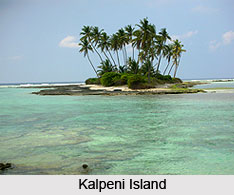 Kalpeni Island is an inhabited island, located in the Union Territory of Lakshadweep Island. It has a population census of 4418 according to 2011 Census.
Kalpeni Island is an inhabited island, located in the Union Territory of Lakshadweep Island. It has a population census of 4418 according to 2011 Census.
Kalpeni Island is located at about 218 kilometres west from the port of Kochi and lies 71 kilometres south of Androth and 201 kilometres to the NNE of Minicoy, with the broad Nine Degree Channel between them. The uninhabited Suheli Par atoll lies 139 kilometres to the east of Kalpeni Island Beach.
Kalpeni Island forms a single coral atoll along with the uninhabited islands of Cheriyam, Tilakkam and Pitti islet, which are not the dwelling places. The eastern and southern shorelines of the Kalpeni Island have accumulations of coral debris, the result of a violent storm that hit the area in 1847. Kalpeni Island was the first island in the Union Territory where women were allowed to go to school and get an education.
Kalpeni Island has a beach at the northern tip which is called Tip Beach. There one can do the snorkelling, sea bath and kayaking. Because of the coral reefs present in the sea near the beach, the water is shallow and calm, making it an excellent spot for beach activities.
There is a 37 meter high lighthouse in Kalpeni Island from whose top one can see a bird`s eye view of the island, the lagoon with the smaller islands, the reef and the surrounding ocean.
From the top of the lighthouse, one can visualize the abundance of coconut trees and the ground is not visible due to dense packing of the tops of these trees. Juma Masjid is one of the architectural monuments situated in this island. The best season to visit Kalpeni Island is winter season. It can be well accessible in onset of summers. The favourable months to visit Kalpeni Island and its beach are between in November to March. The climate of Kalpeni Island remains pleasant during these months, which are offering tourists the best holiday experience. November marks the beginning of the winter season in Kalpeni Island and it lasts till the month of February. Winters are pleasant here with the temperature range between a moderate 12 degree Celsius to 20 degree Celsius. The place looks amazing in the month of November. The summer season is moderately hot and humid in Kalpeni Island and generally last between the months of April to June. The temperature of Kalpeni Island ranges between a comfortable 27 degree Celsius to 33 degree Celsius in these months. The Kalpeni Island receives heavy rainfall during the months of May to September. The place remains drenched all through these months.



















